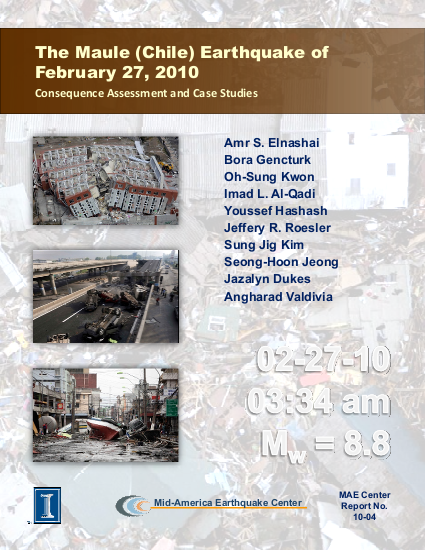
On February 27, 2010, a powerful earthquake of magnitude 8.8 struck central Chile. The epicenter of the earthquake was approximately 8 km off the central region of the Chilean coast. With an inclined rupture area of more than 80,000 square km that extends onshore, the region of Maule was subjected to a direct hit, with intense shaking of duration of at least 100 seconds, and peak horizontal and vertical ground acceleration of over 0.6 g. The earthquake caused the death of 521 persons, with almost half of the fatalities caused by the consequential tsunami. Over 800,000 individuals were directly affected through death, injury and displacement. More than a third of a million buildings were damaged to varying degrees, including several cases of total collapse of major structures. The transportation system was dealt a crippling blow, with 830 failures registered with the Ministry of Public Works on roads in both the public and private transportation networks. Disruption of commerce as well as the rescue and response effort resulted from the damage to roads, embankments and bridges.
On the whole, the performance of engineered structures was reasonable, taking into account the magnitude and proximity of the earthquake. The latter conclusion is supported by the observations from several back-analyses presented in this report. Damage to non-engineered construction is as expected in major earthquakes. Most reinforced concrete bridges behaved well.
The role of social networking tools in enabling the affected population to communicate was a most interesting feature in the response to this earthquake. Due to the failure of the power grid, and the congestion of the cellphone network, the population resorted to short message service and web social media. Ham radio networks were activated to fill gaps due to the failure of the radio network in places. The failure in ham radio broadcast in coastal regions might have increased the fatalities because tsunami warning did not reach all hazardous locations.
The MAE Center field reconnaissance team members consider that Chilean engineering was proven to be robust and that seismic design provisions and construction practices are of high standard. The extensive damage from this Mw = 8.8 earthquake is expected and within the ‘life safety’ performance target of seismic design codes.
Links
Resource collections
- Earthquakes
- Learning from crises
- Topics
- UN Habitat - Urban Response Collection
- Urban Response - Urban Crisis Preparedness and Risk Reduction
- Urban Response Collection - Community Engagement and Social Cohesion
- Urban Response Collection - Economic Recovery
- Urban Response Collection - Environment and Climate Change
- Urban Response Collection - Housing, Land and Property
- Urban Response Collection - Urban Crisis Response, Recovery and Reconstruction
- Urban Response Collection - Urban Resilience
